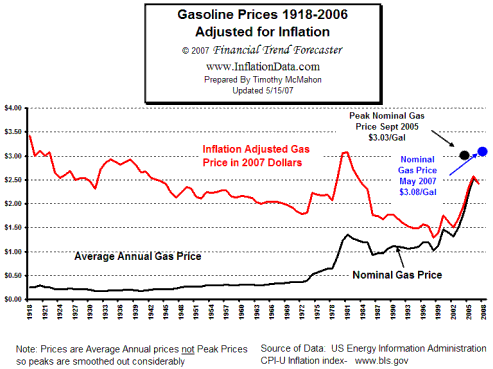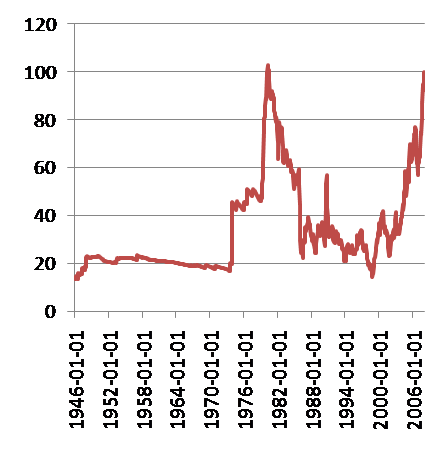$3/gallon gasoline is not shocking for people any more as we’ve seen prices at that level for some time now. But the latest Energy Dept forecast calls for prices to peak at $3.40/gal in the Spring, though given how fast they have risen already, some expect $4/gallon is not out of the realm of possibility. Just the other day I drove into town in the morning and it was $3.05, after breakfast it was $3.09 and by soccer practice it was $3.20! When you adjust for inflation, gas prices are at or have surpassed the all-time peak set in 1981, depending who you ask. With the cost of travel skyrocketing, when will that have an effect on youth soccer?
The folks at inflationdata.com have a nice historical chart that shows inflation adjusted gas prices up through about May 2007. This doesn’t take the recent runup into account, but prices are close to May 2007 levels now, so it gives you an idea of where we are:

Paul Krugman in the NY Times has a more recent graph of oil prices, adjusted for inflation, that shows a similar runup to record price levels. Remember that 68% of the cost of a gallon of gasoline is the oil, the rest is taxes, distribution, refining, and marketing which aren’t as volatile:

The key thing about these graphs is the trough in each. Gas and oil were VERY cheap from about 1984 through 2003, a period when youth soccer absolutely exploded in this country. While a majority of youth soccer players play in local recreational leagues, a sizable number play in competitive travel leagues. As the skill level of players increases, the distances traveled often do as well. Competitive soccer players often travel to tournaments that can be in far away cities or even different states. While some parents easily spend thousands of dollars for their kids to play soccer and likely won’t be severely affected by the increased cost of gasoline, many other families will.
Consider most SUVs get around 15 MPG while mini-vans get 18-20MPG, you’re looking at 15-20 cents per mile with current gas prices in the more common modes of transportation for soccer families. Competitive teams may travel hundreds of miles to games and some elite players travel many miles 3-5 days a week to practice and play with top teams. When it starts to cost $30-$60 in gas for each match, it will start to have an impact for some families. The question is at what point does it impact so many families that we start to see a change in youth soccer as a whole?
Will we start to see players migrate to divisions where the travel is less extensive? Will upper level leagues reduce cross-state travel and focus more on regional matchups? Will local tournaments become more popular than those that usually attracted teams from across nearby states? Will more talented players start to stay in mid level divisions where the travel requirements are less severe? Or will most families just absorb the increased travel costs and cut back elsewhere? If changes like these don’t happen across the spectrum, will we see changes within certain age groups where collegiate exposure is not as important? Will younger players stay in regional travel leagues longer instead of jumping to leagues that play state wide. Will leagues find they can no longer get by with financial aid programs limited to registration fees? Will they need to start supplementing travel costs for players in financial need? Will they even be able to?
I don’t have answers to these questions, but given the drastic changes we’re seeing in the costs of travel, you have to expect there will be some impacts. What do you think they might be and how widespread will they be?
Adding: The NY Times has a more recent (and nicer looking) graph which shows that we just went past the inflation adjusted high of the 1980’s.





August 22nd, 2008 at 11:55 am
Travel soccer is a racket. You don’t need to travel 100miles to find other kids who want to keep score in a soccer game. I played competitive youth soccer when I was a teenager, I was coached by a former professional player from the NASL(Detroit Express)who charged my parents $60.00 per season!! We played in a league that covered around 150miles, but we never spent the night in a hotel. I played with and against players who got college scholarships and and two U.S. Olympians. Everyone knows that high school soccer is really the most competitive and high school teams only travel overnight during the end of the season tournaments. Wake up parents and take some control of your family life!!
David